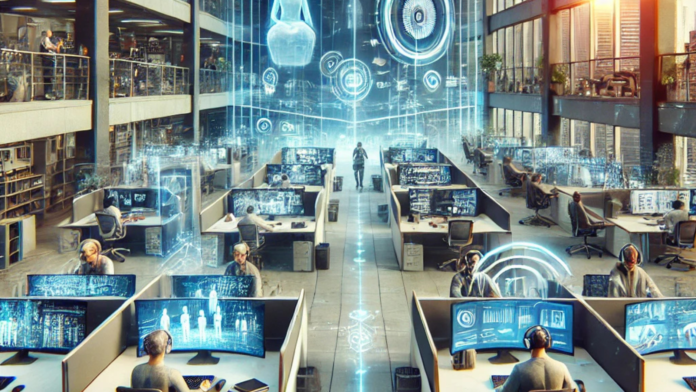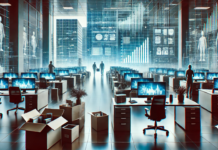The COVID-19 pandemic forced a rapid and unprecedented shift to remote work, disrupting traditional office spaces across the globe. As companies and employees adapted to this new way of working, many began to question the necessity of physical office spaces. Is the office dead? Or will it evolve to meet the changing demands of the workforce?
In this article, we explore the future of office spaces, analyzing trends, challenges, and potential paths forward in a post-pandemic world.
The Changing Landscape of Work
Before the pandemic, offices were seen as the central hub of business operations. However, with widespread lockdowns, businesses were forced to adopt remote work models, which proved not only feasible but, in many cases, more productive. This shift has sparked an ongoing debate about the future relevance of office spaces. Let’s examine some key trends shaping the future:
1. Remote and Hybrid Work Models
A major shift in work culture is the rise of hybrid work models, where employees split time between working remotely and in the office. Many companies have embraced this flexible approach, realizing that not all tasks require in-person collaboration. Companies like Google and Microsoft are adopting hybrid models, allowing employees to come into the office for specific purposes like brainstorming, team meetings, or social events, while working remotely for day-to-day tasks.
The Future Implication: The office will likely transform into a collaboration hub rather than a mandatory daily workplace. Employees may only visit for essential face-to-face interactions, significantly reducing the need for large office spaces.
2. Technological Advancements
Technology is a key driver of the shift in how we view office spaces. Tools like Zoom, Slack, Microsoft Teams, and cloud-based systems have enabled seamless collaboration from anywhere in the world. Additionally, innovations like virtual reality (VR) and augmented reality (AR) could redefine virtual meetings and team collaboration, providing immersive environments that simulate the experience of being in the same room.
The Future Implication: As technology continues to evolve, virtual collaboration tools will become more advanced, making remote work even more efficient. Offices may evolve into technologically enhanced spaces designed for specialized tasks, rather than places where employees spend every working day.
3. The Rise of Co-Working Spaces
Co-working spaces, already popular before the pandemic, are likely to see further growth as companies downsize or eliminate traditional offices. These shared spaces offer flexibility and cost savings, allowing companies to rent space on an as-needed basis. They are ideal for remote workers who need a temporary office environment or a place for team gatherings. Co-working spaces are also hubs for networking and collaboration, making them attractive to freelancers and startups.
The Future Implication: With the increase in hybrid and remote work, demand for co-working spaces will likely rise. These spaces may serve as an alternative to traditional offices for businesses that no longer require permanent, full-scale office setups.
Will the Office Disappear Completely?
While remote work has proven successful, it is unlikely that the office will disappear entirely. For many companies, office spaces provide a critical environment for fostering company culture, collaboration, and innovation. Some employees also prefer working in an office for reasons such as better access to resources, structured environments, and the social aspect of working alongside colleagues.
However, the purpose of the office will likely change. Instead of being a place where employees clock in daily, it may become a multifunctional space that serves several roles:
– Collaboration Hubs: Offices may be redesigned to foster creativity and collaboration, with open layouts, meeting rooms, and breakout areas.
– Flexible Spaces: Offices could become more dynamic, offering hot-desking options or modular workspaces that can be adjusted to meet the needs of different teams or projects.
– Cultural Anchors: For companies that value in-person interactions, the office may become a place where employees gather for social events, team-building activities, and cultural alignment.
Key Challenges in the Transition
1. Maintaining Company Culture
A significant challenge with remote and hybrid work is maintaining a strong company culture. Offices have traditionally been a place where corporate values are demonstrated, and where employees build relationships with their colleagues. Remote work, while effective, can dilute these cultural bonds, especially if face-to-face interactions are limited.
How to Address It: Companies may need to invest in regular in-person meetings, team-building activities, and strong digital culture-building initiatives to maintain a sense of unity and shared purpose among remote teams.
2. Equity and Inclusivity
Hybrid work models can create disparities between remote and in-office employees. Those who come into the office regularly may have more access to managers and resources, leading to concerns about inequitable treatment. Similarly, certain employees may have less ideal home working conditions, making office access more critical for them.
How to Address It: Businesses need to ensure that all employees, whether remote or in-office, have equal opportunities for career progression, mentorship, and access to resources. Offering stipends for home office equipment or providing access to co-working spaces can help balance these inequalities.
3. Real Estate and Infrastructure Costs
For companies that maintain large office spaces, the question of cost-efficiency is central. With reduced in-person attendance, maintaining large and expensive office buildings may no longer make sense. Downsizing or adopting more flexible lease options could be a solution, but it requires careful planning and negotiation.
How to Address It: Companies should re-evaluate their real estate needs and consider moving to smaller, more flexible spaces. Shared office models or partnerships with co-working spaces could also be cost-effective alternatives.
Conclusion: A New Role for the Office
The future of office spaces is not about whether the office is dead, but about how it will evolve to meet the changing needs of businesses and employees. The office will likely shift from a mandatory location to a purposeful destination—used for collaboration, culture-building, and innovation. Remote and hybrid work models will continue to thrive, supported by advancements in technology and flexible workplace solutions like co-working spaces.
In this evolving landscape, businesses must remain adaptable, embracing new models of work that prioritize employee well-being, productivity, and inclusivity. The office, far from dead, will simply take on a new life.















